Abstract
1. Heat acclimation was induced in eight subjects by asking them to exercise until exhaustion at 60% of maximum oxygen consumption rate (VO2) for 9-12 consecutive days at an ambient temperature of 40 degrees C, with 10% relative humidity (RH). Five control subjects exercised similarly in a cool environment, 20 degrees C, for 90 min for 9-12 days; of these, three were exposed to exercise at 40 degrees C on the first and last day. 2. Acclimation had occurred as seen by the increased average endurance from 48 min to 80 min, the lower rate of rise in the heart rate (HR) and core temperature and the increased sweating. 3. Cardiac output increased significantly from the first to the final heat exposure from 19.6 to 21.4 l min-1; this was possibly due to an increased plasma volume and stroke volume. 4. The mechanism for the increased plasma volume may be an isosmotic volume expansion caused by influx of protein to the vascular compartment, and a sodium retention induced by a significant increase in aldosterone. 5. The exhaustion coincided with, or was elicited when, core temperature reached 39.7 +/- 0.15 degrees C; with progressing acclimation processes it took progressively longer to reach this level. However, at this point we found no reduction in cardiac output, muscle (leg) blood flow, no changes in substrate utilization or availability, and no recognized accumulated 'fatigue' substances. 6. It is concluded that the high core temperature per se, and not circulatory failure, is the critical factor for the exhaustion during exercise in heat stress.
Full text
PDF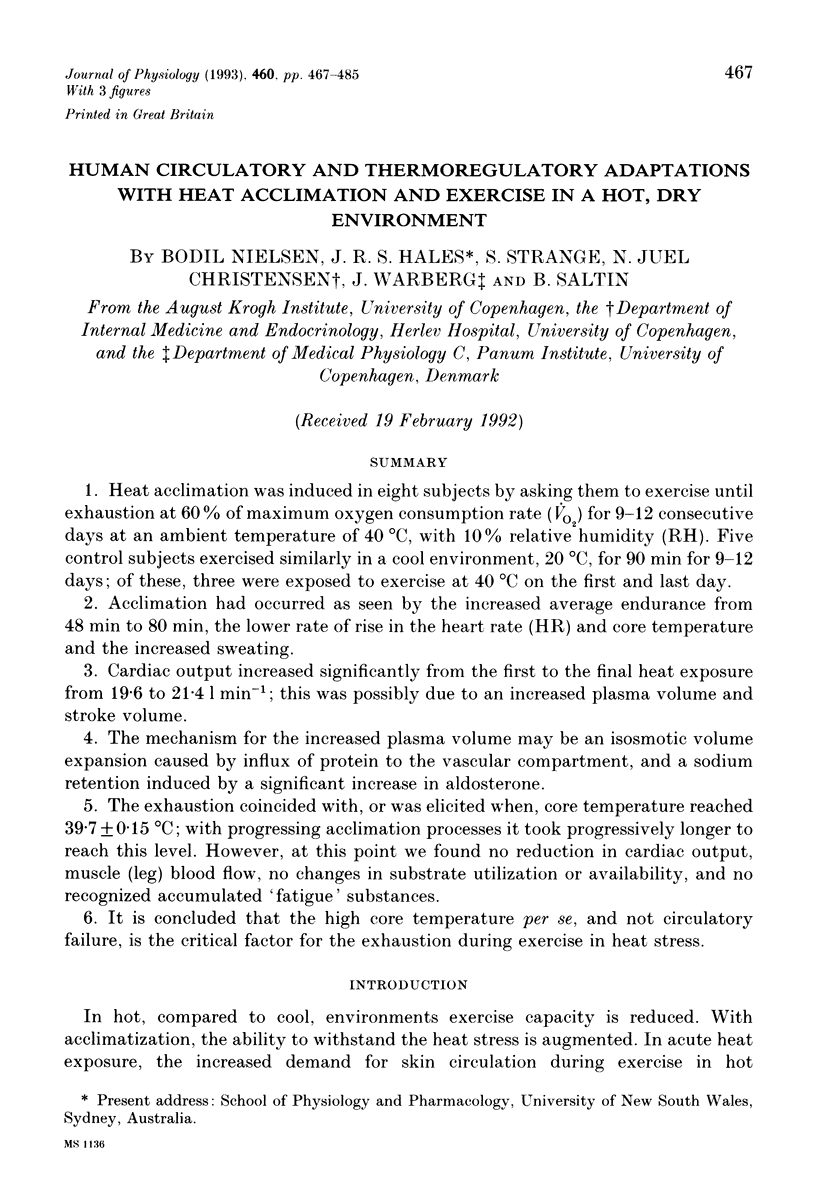
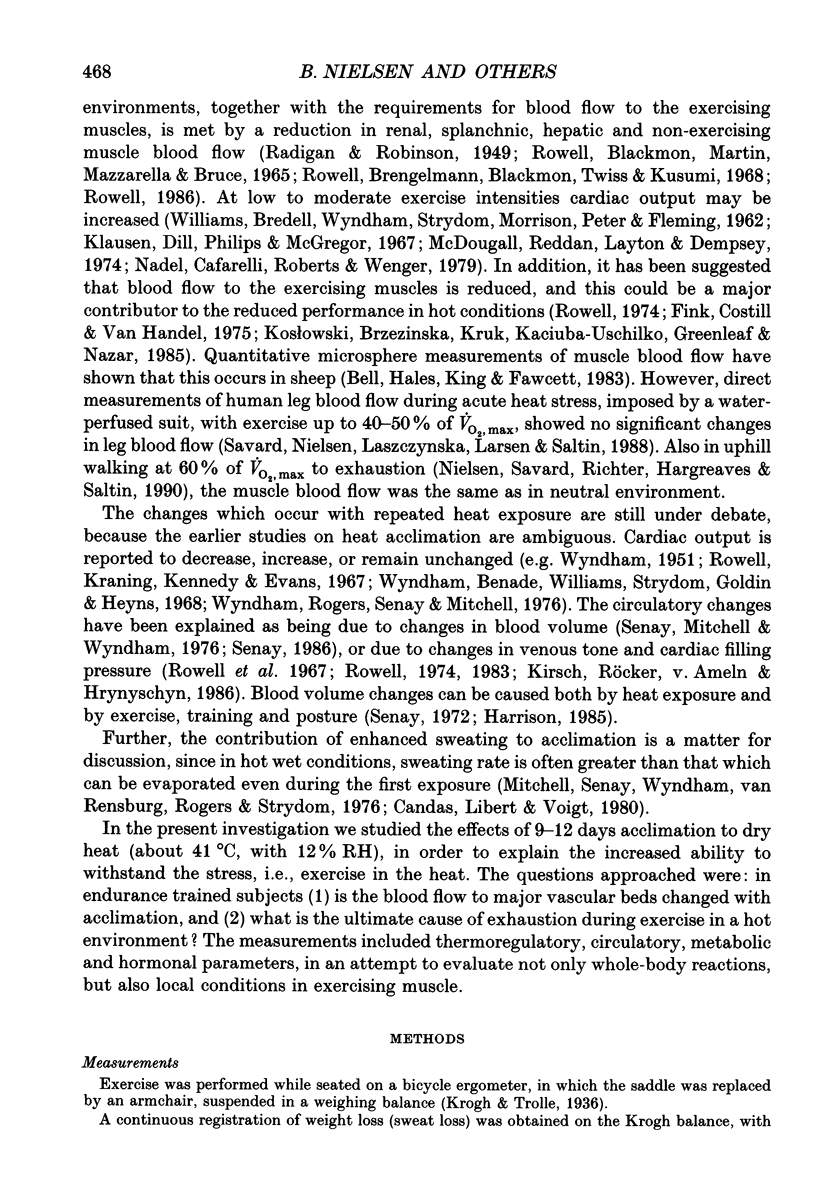
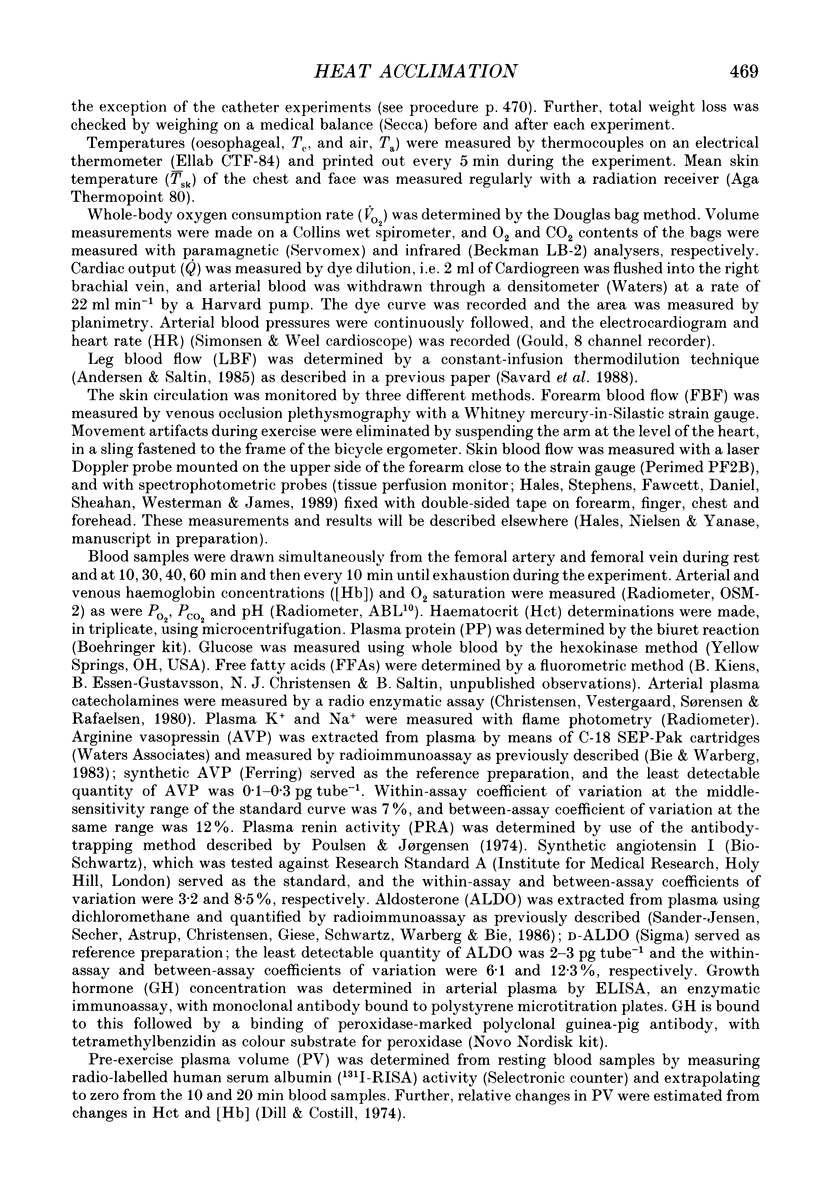
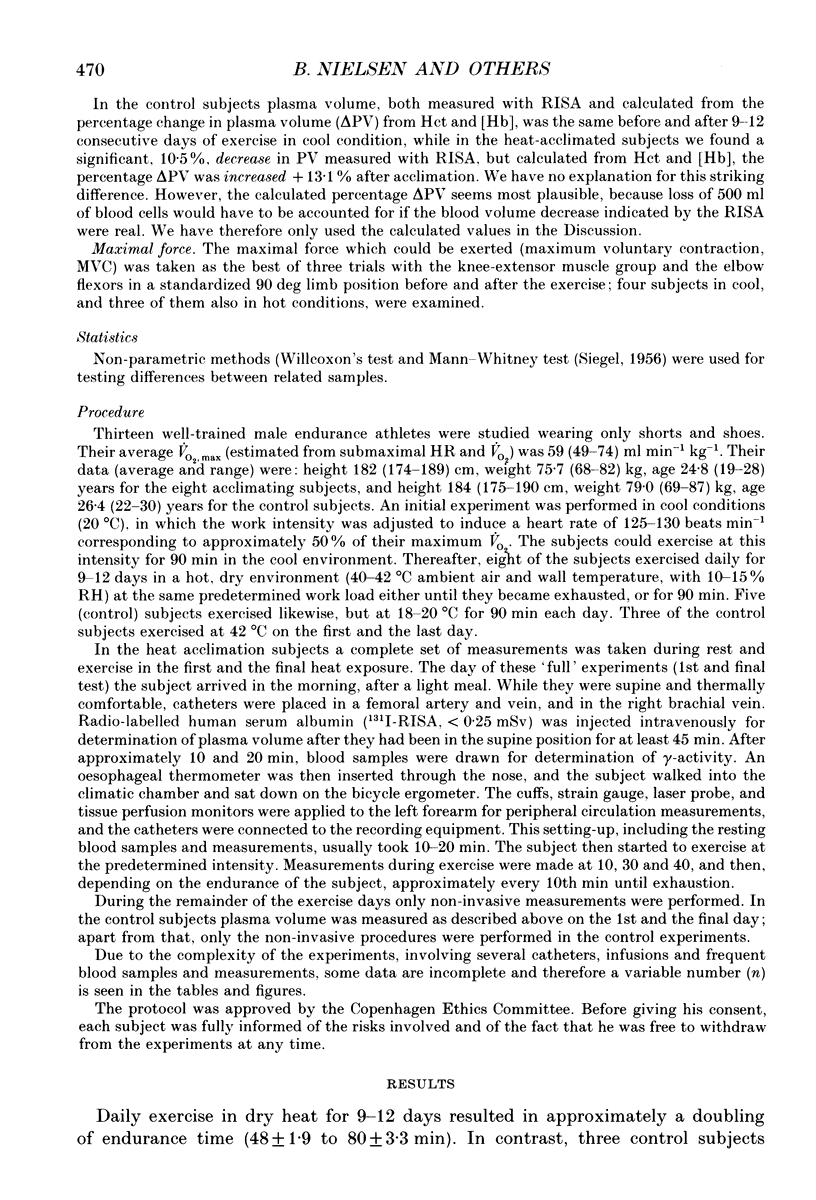
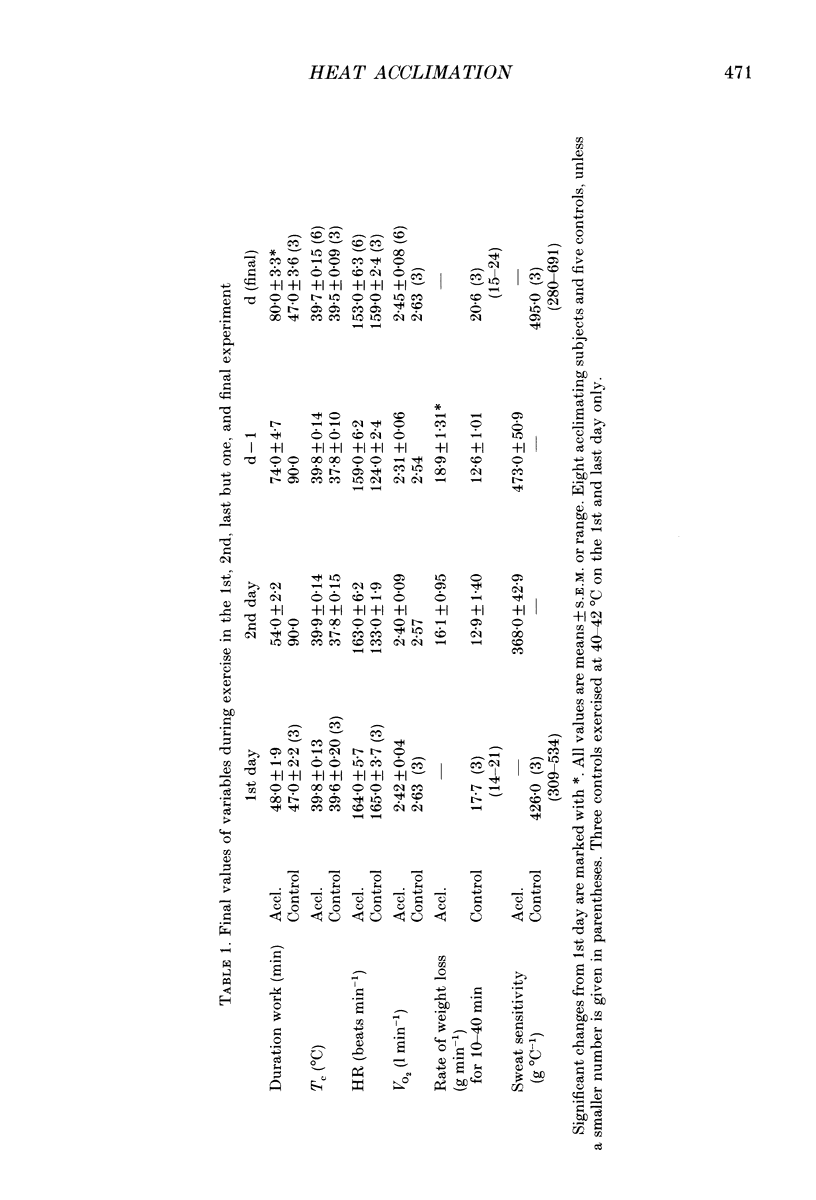
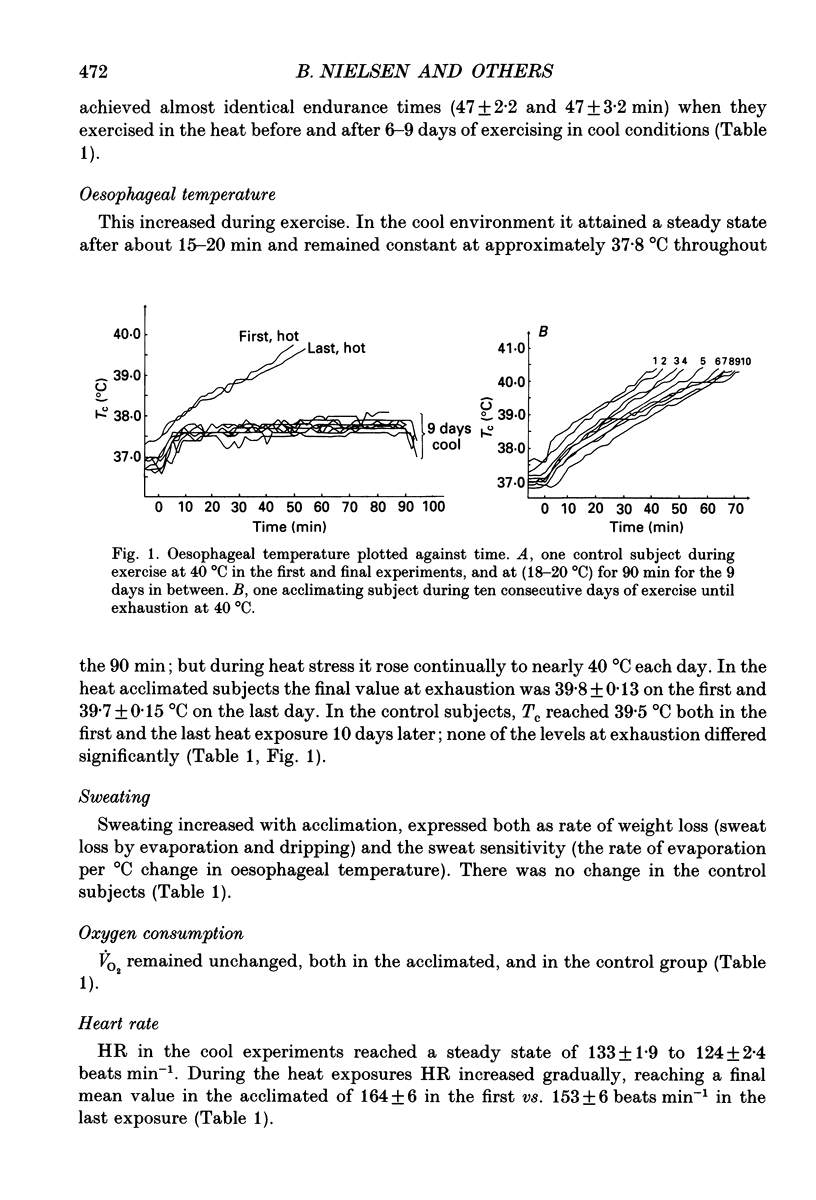
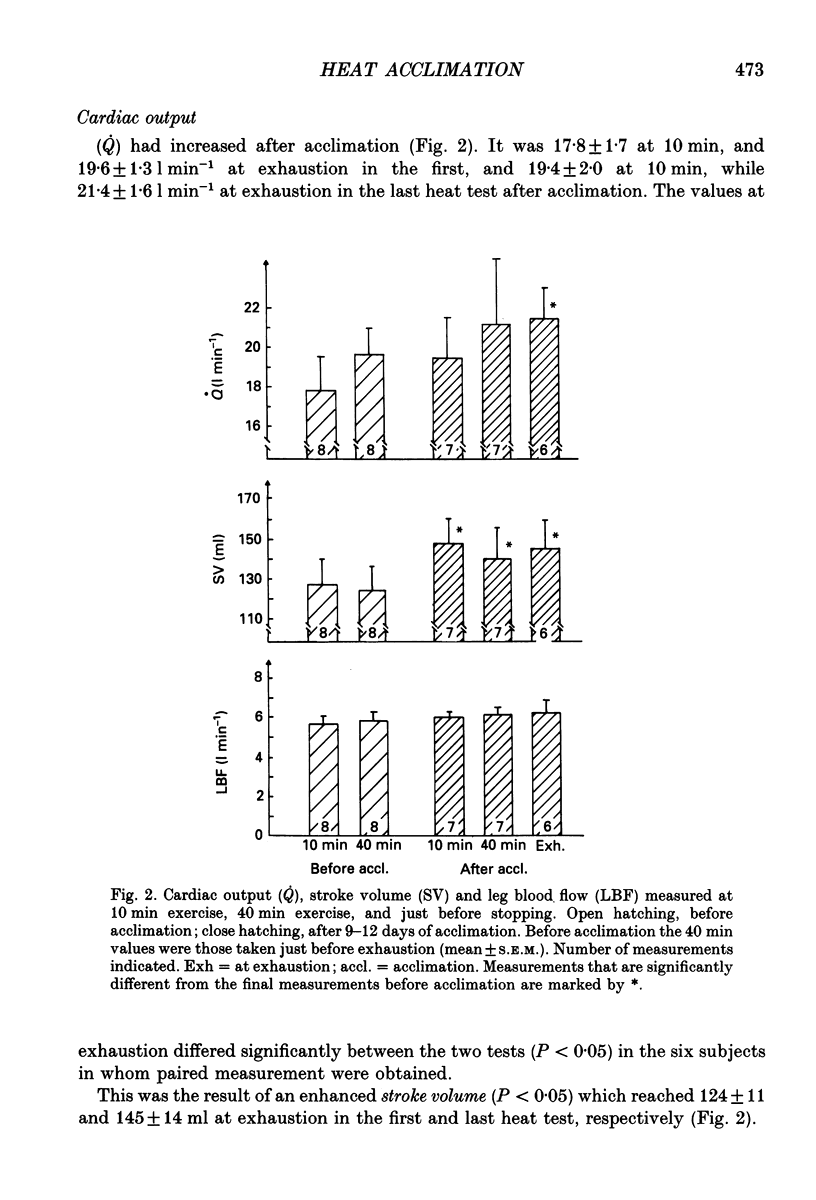
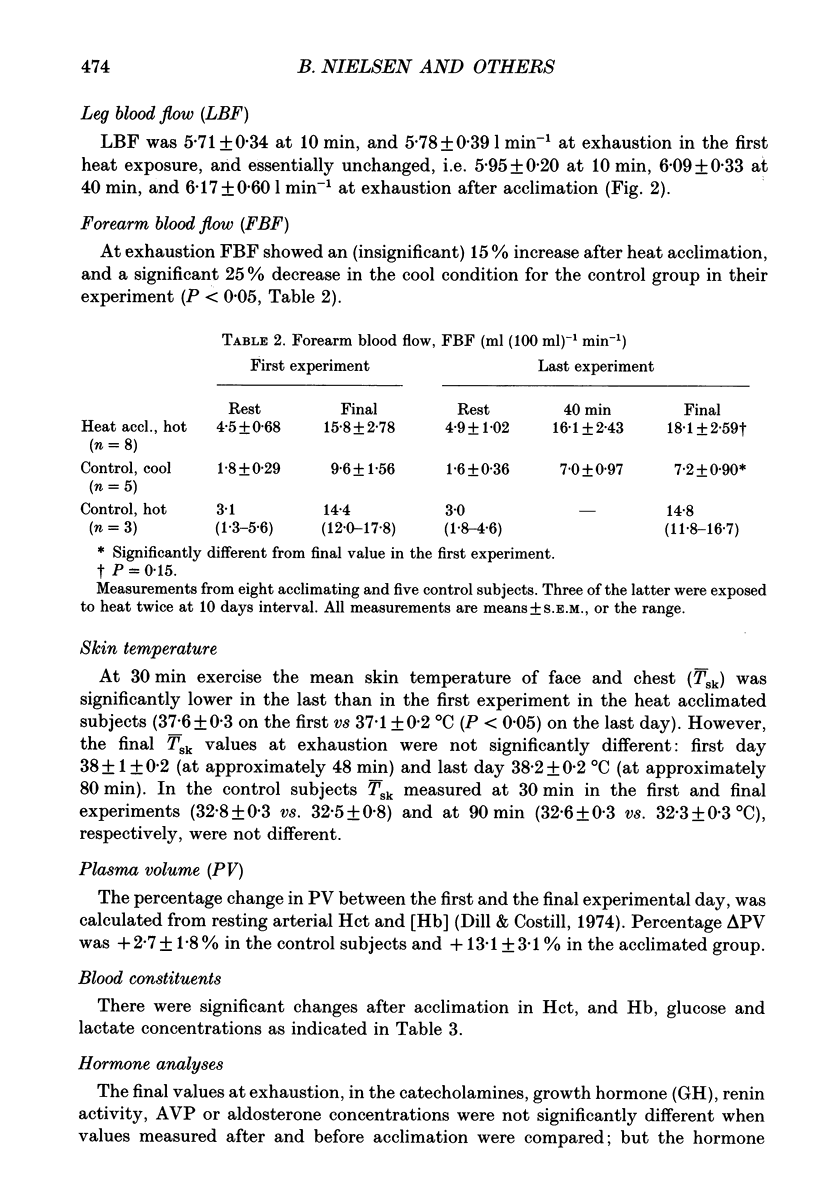
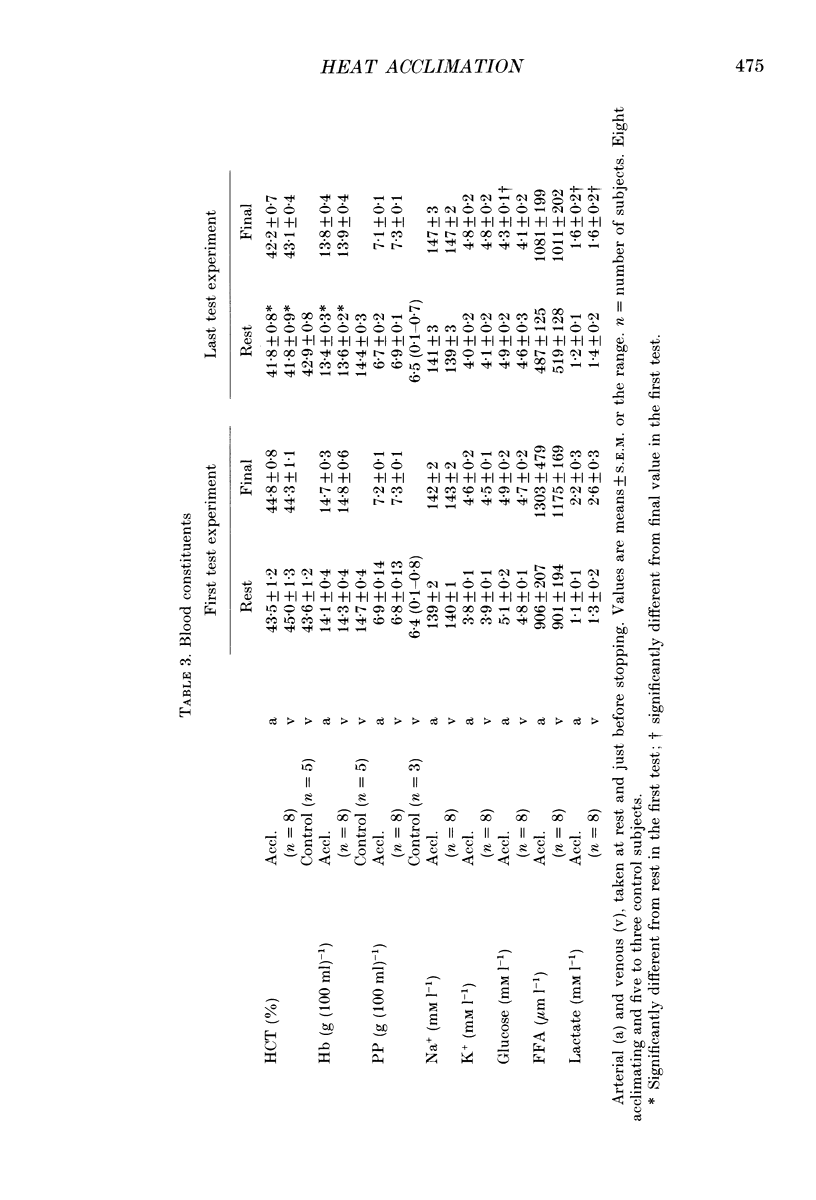
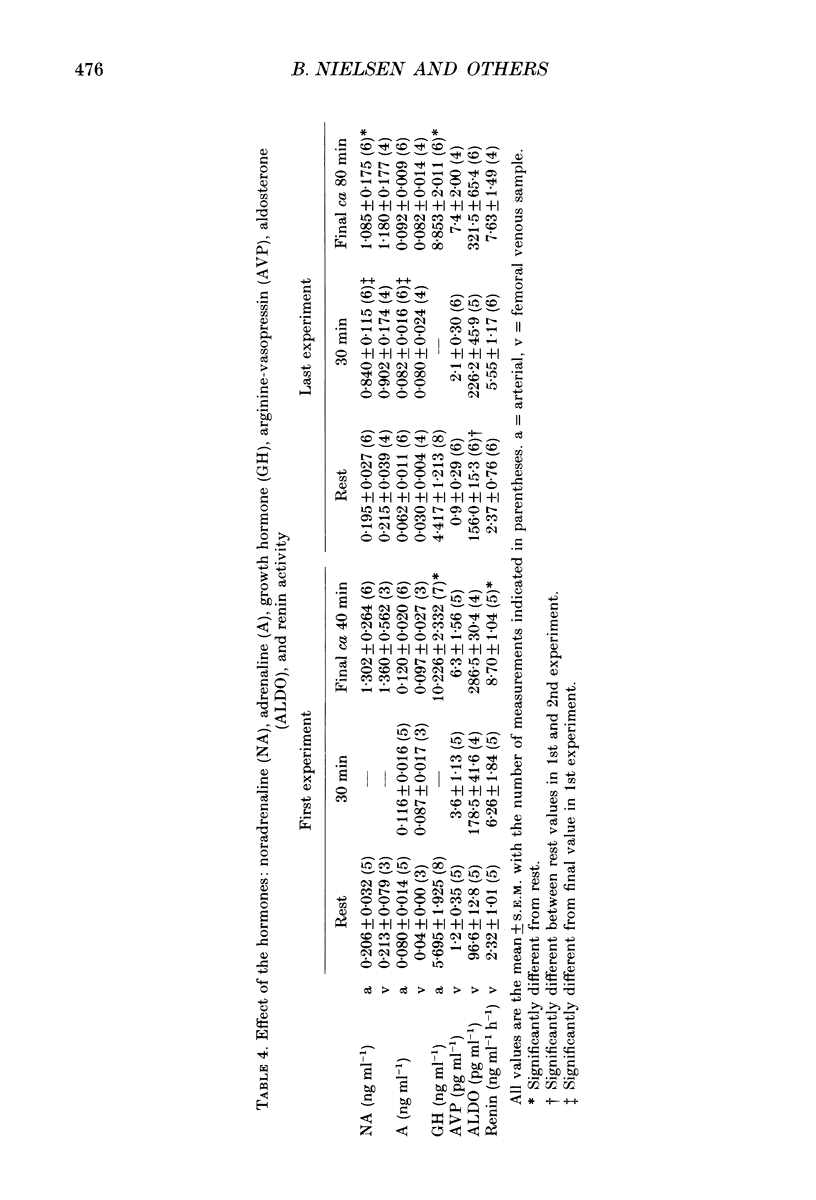

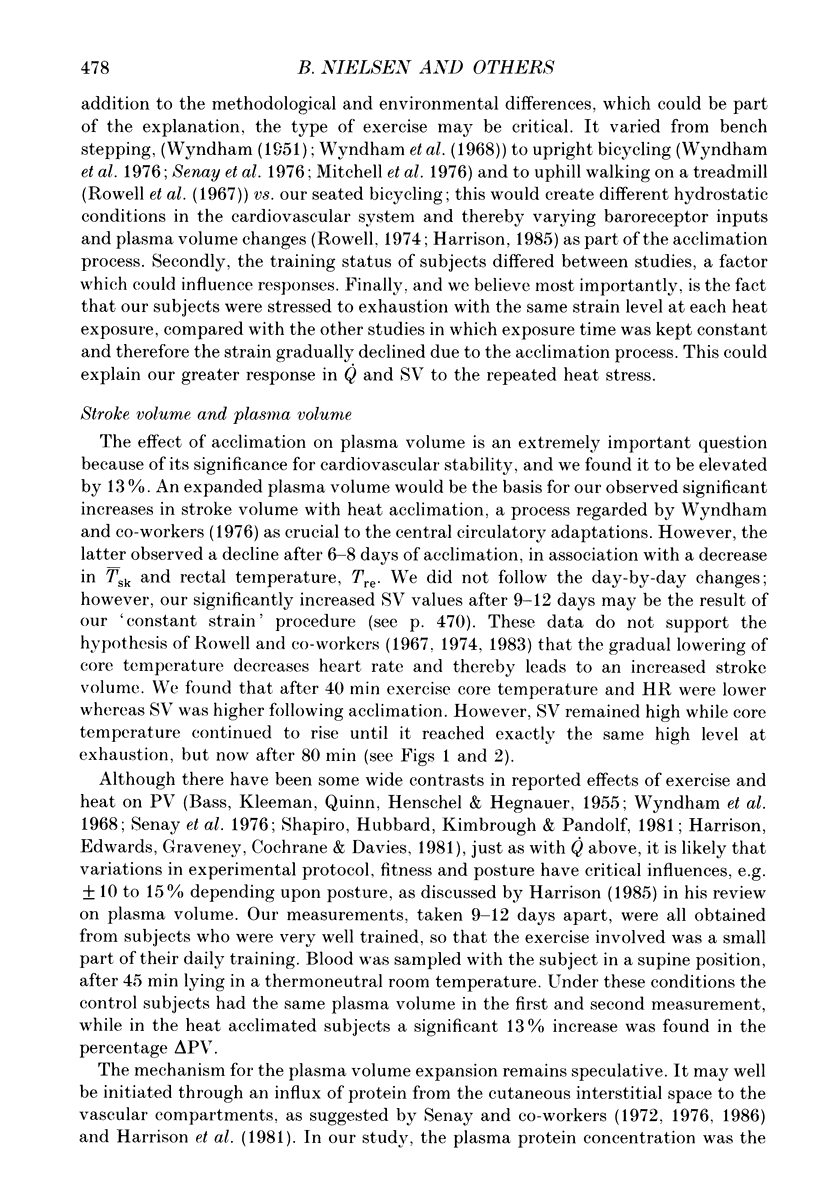
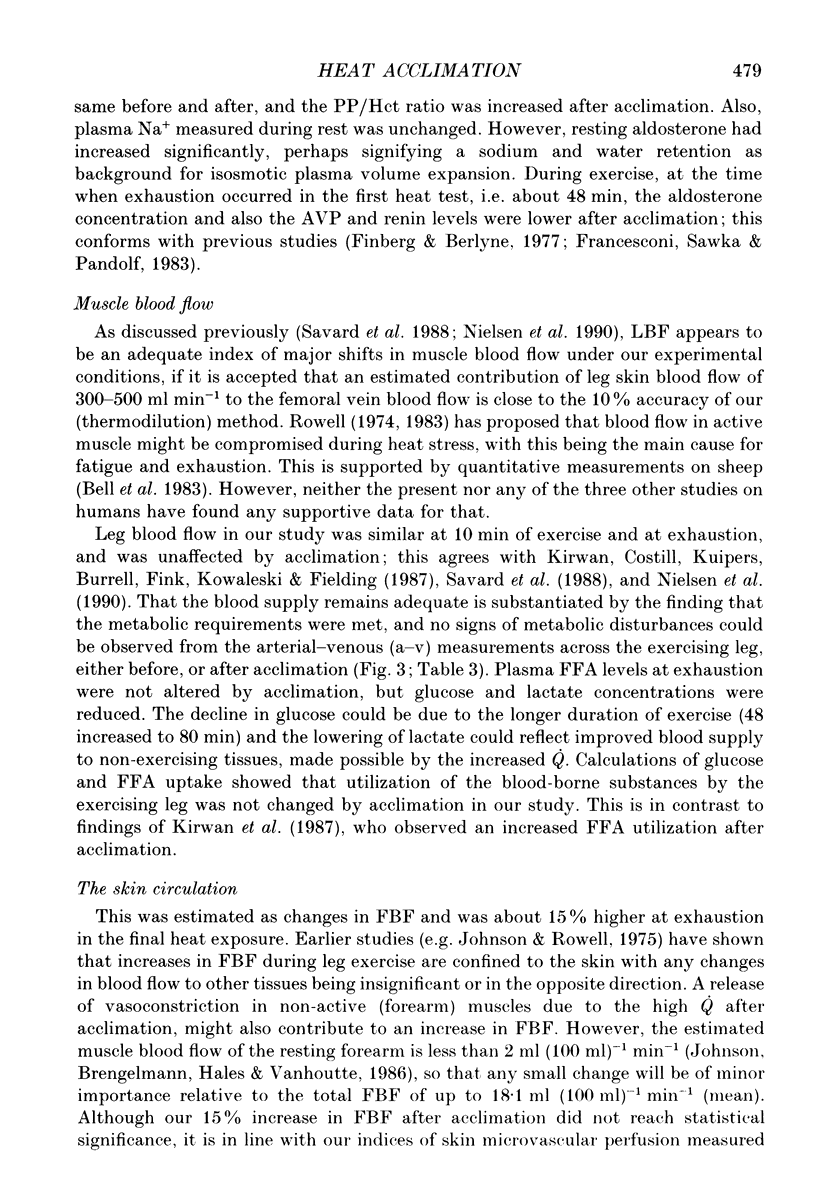
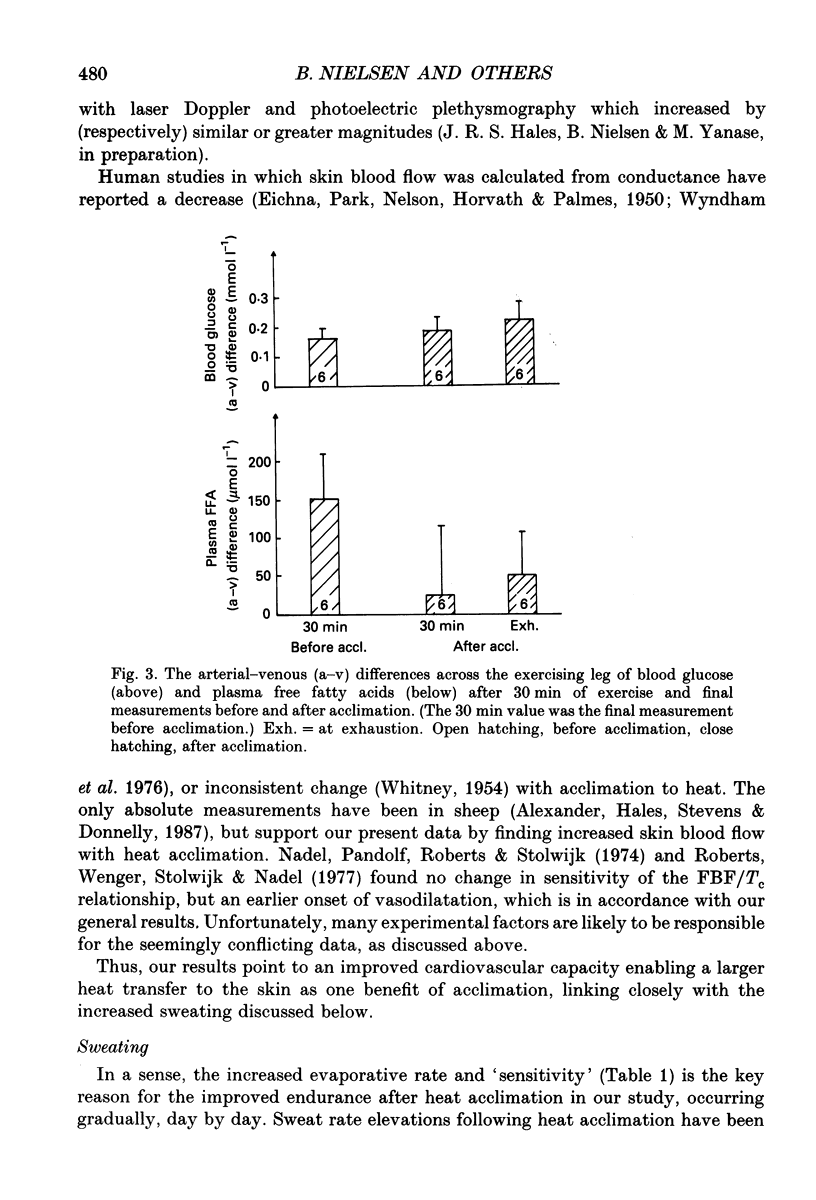
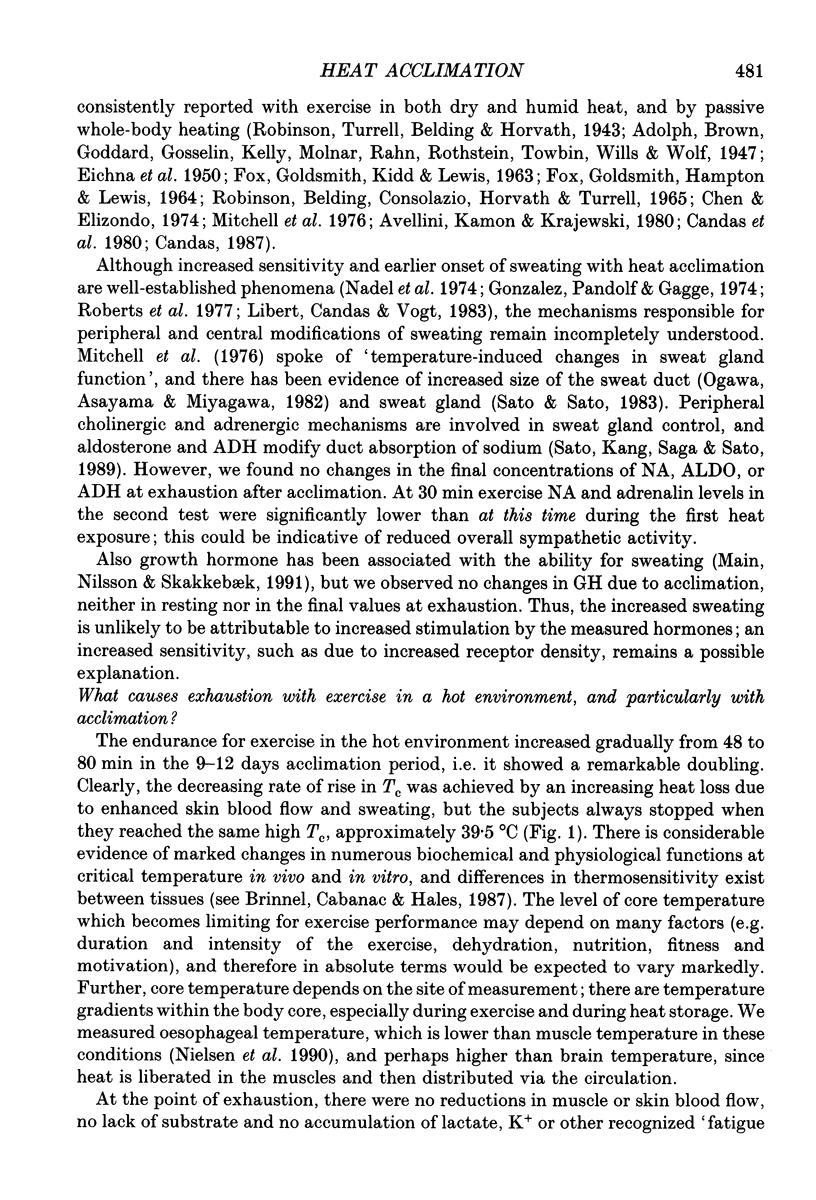
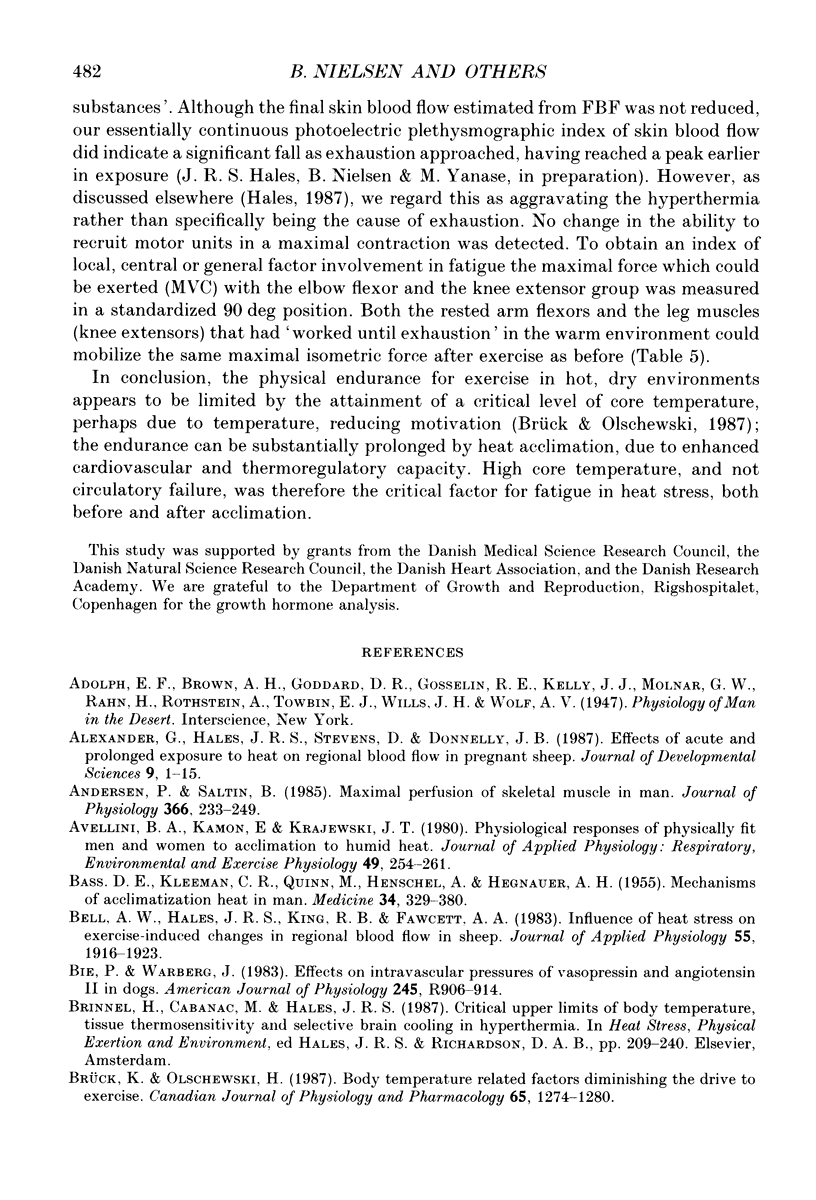
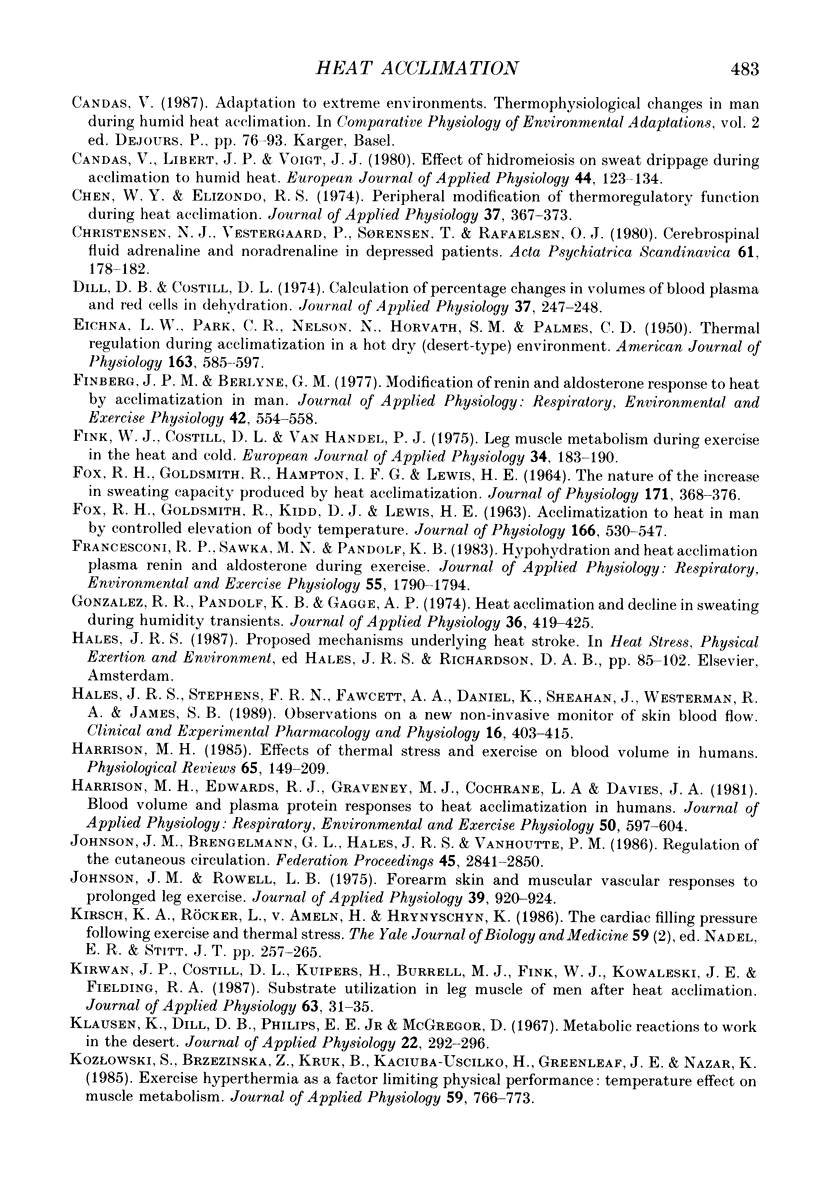
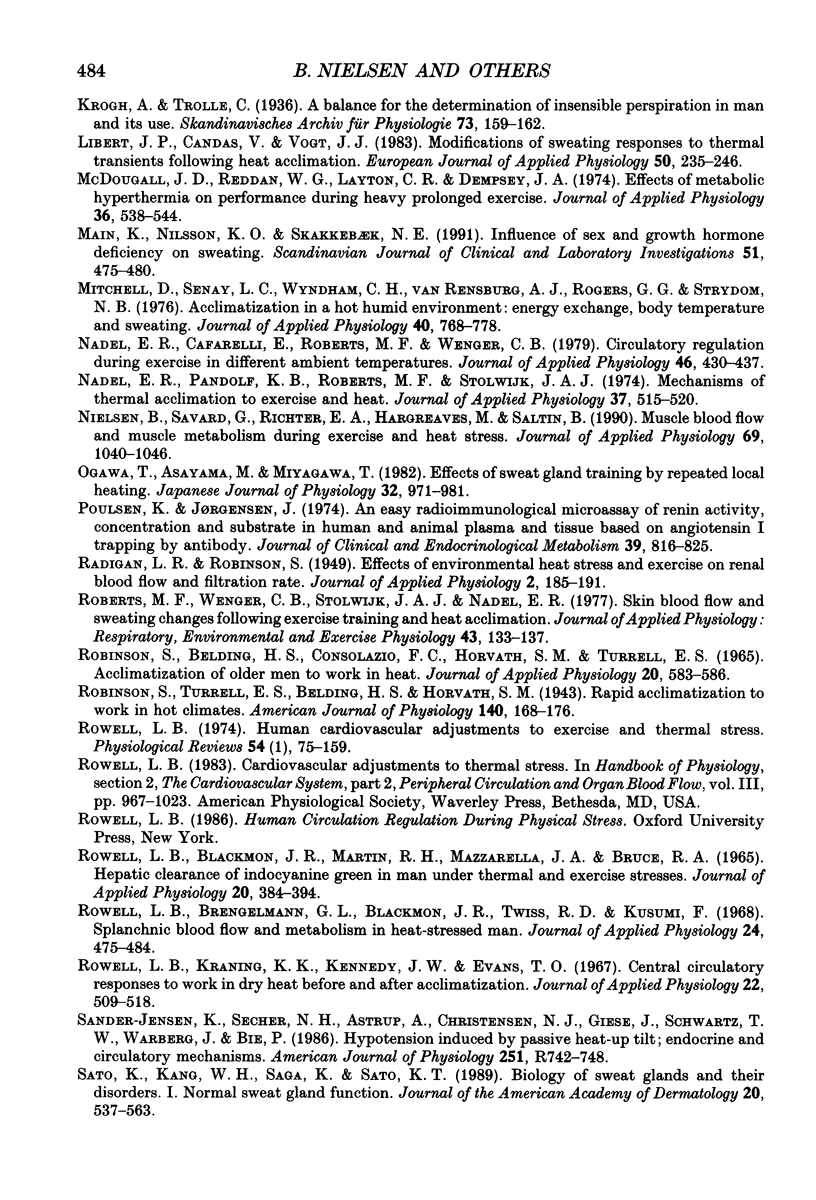
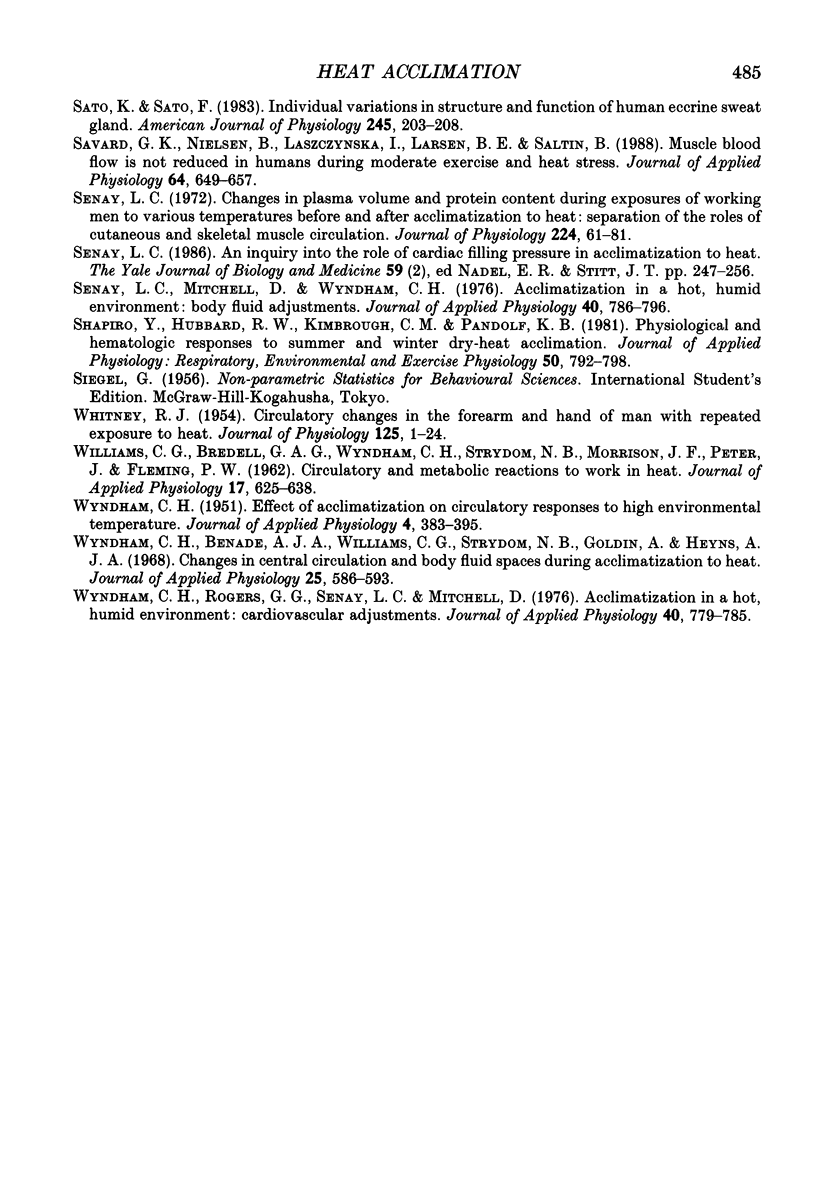
Selected References
These references are in PubMed. This may not be the complete list of references from this article.
- Alexander G., Hales J. R., Stevens D., Donnelly J. B. Effects of acute and prolonged exposure to heat on regional blood flows in pregnant sheep. J Dev Physiol. 1987 Feb;9(1):1–15. [PubMed] [Google Scholar]
- Andersen P., Saltin B. Maximal perfusion of skeletal muscle in man. J Physiol. 1985 Sep;366:233–249. doi: 10.1113/jphysiol.1985.sp015794. [DOI] [PMC free article] [PubMed] [Google Scholar]
- Avellini B. A., Kamon E., Krajewski J. T. Physiological responses of physically fit men and women to acclimation to humid heat. J Appl Physiol Respir Environ Exerc Physiol. 1980 Aug;49(2):254–261. doi: 10.1152/jappl.1980.49.2.254. [DOI] [PubMed] [Google Scholar]
- BASS D. E., KLEEMAN C. R., QUINN M., HENSCHEL A., HEGNAUER A. H. Mechanisms of acclimatization to heat in man. Medicine (Baltimore) 1955 Sep;34(3):323–380. doi: 10.1097/00005792-195509000-00002. [DOI] [PubMed] [Google Scholar]
- Bell A. W., Hales J. R., King R. B., Fawcett A. A. Influence of heat stress on exercise-induced changes in regional blood flow in sheep. J Appl Physiol Respir Environ Exerc Physiol. 1983 Dec;55(6):1916–1923. doi: 10.1152/jappl.1983.55.6.1916. [DOI] [PubMed] [Google Scholar]
- Bie P., Warberg J. Effects on intravascular pressures of vasopressin and angiotensin II in dogs. Am J Physiol. 1983 Dec;245(6):R906–R914. doi: 10.1152/ajpregu.1983.245.6.R906. [DOI] [PubMed] [Google Scholar]
- Brück K., Olschewski H. Body temperature related factors diminishing the drive to exercise. Can J Physiol Pharmacol. 1987 Jun;65(6):1274–1280. doi: 10.1139/y87-203. [DOI] [PubMed] [Google Scholar]
- Chen W. Y., Elizondo R. S. Peripheral modification of thermoregulatory function during heat acclimation. J Appl Physiol. 1974 Sep;37(3):367–373. doi: 10.1152/jappl.1974.37.3.367. [DOI] [PubMed] [Google Scholar]
- Christensen N. J., Vestergaard P., Sørensen T., Rafaelsen O. J. Cerebrospinal fluid adrenaline and noradrenaline in depressed patients. Acta Psychiatr Scand. 1980 Feb;61(2):178–182. doi: 10.1111/j.1600-0447.1980.tb00577.x. [DOI] [PubMed] [Google Scholar]
- Dill D. B., Costill D. L. Calculation of percentage changes in volumes of blood, plasma, and red cells in dehydration. J Appl Physiol. 1974 Aug;37(2):247–248. doi: 10.1152/jappl.1974.37.2.247. [DOI] [PubMed] [Google Scholar]
- EICHNA L. W., PARK C. R., NELSON N., HORVATH S. M., PALMES E. D. Thermal regulation during acclimatization in a hot, dry (desert type) environment. Am J Physiol. 1950 Dec;163(3):585–597. doi: 10.1152/ajplegacy.1950.163.3.585. [DOI] [PubMed] [Google Scholar]
- FOX R. H., GOLDSMITH R., HAMPTON I. F., LEWIS H. E. THE NATURE OF THE INCREASE IN SWEATING CAPACITY PRODUCED BY HEAT ACCLIMATIZATION. J Physiol. 1964 Jun;171:368–376. doi: 10.1113/jphysiol.1964.sp007382. [DOI] [PMC free article] [PubMed] [Google Scholar]
- FOX R. H., GOLDSMITH R., KIDD D. J., LEWIS H. E. Acclimatization to heat in man by controlled elevation of body temperature. J Physiol. 1963 May;166:530–547. doi: 10.1113/jphysiol.1963.sp007121. [DOI] [PMC free article] [PubMed] [Google Scholar]
- Finberg J. P., Berlyne G. M. Modification of renin and aldosterone response to heat by acclimatization in man. J Appl Physiol Respir Environ Exerc Physiol. 1977 Apr;42(4):554–558. doi: 10.1152/jappl.1977.42.4.554. [DOI] [PubMed] [Google Scholar]
- Fink W. J., Costill D. L., Van Handel P. J. Leg muscle metabolism during exercise in the heat and cold. Eur J Appl Physiol Occup Physiol. 1975 Aug 15;34(3):183–190. doi: 10.1007/BF00999931. [DOI] [PubMed] [Google Scholar]
- Francesconi R. P., Sawka M. N., Pandolf K. B. Hypohydration and heat acclimation: plasma renin and aldosterone during exercise. J Appl Physiol Respir Environ Exerc Physiol. 1983 Dec;55(6):1790–1794. doi: 10.1152/jappl.1983.55.6.1790. [DOI] [PubMed] [Google Scholar]
- Gonzalez R. R., Pandolf K. B., Gagge A. P. Heat acclimation and decline in sweating during humidity transients. J Appl Physiol. 1974 Apr;36(4):419–425. doi: 10.1152/jappl.1974.36.4.419. [DOI] [PubMed] [Google Scholar]
- Hales J. R., Stephens F. R., Fawcett A. A., Daniel K., Sheahan J., Westerman R. A., James S. B. Observations on a new non-invasive monitor of skin blood flow. Clin Exp Pharmacol Physiol. 1989 May;16(5):403–415. doi: 10.1111/j.1440-1681.1989.tb01578.x. [DOI] [PubMed] [Google Scholar]
- Harrison M. H., Edwards R. J., Graveney M. J., Cochrane L. A., Davies J. A. Blood volume and plasma protein responses to heat acclimatization in humans. J Appl Physiol Respir Environ Exerc Physiol. 1981 Mar;50(3):597–604. doi: 10.1152/jappl.1981.50.3.597. [DOI] [PubMed] [Google Scholar]
- Harrison M. H. Effects on thermal stress and exercise on blood volume in humans. Physiol Rev. 1985 Jan;65(1):149–209. doi: 10.1152/physrev.1985.65.1.149. [DOI] [PubMed] [Google Scholar]
- Johnson J. M., Brengelmann G. L., Hales J. R., Vanhoutte P. M., Wenger C. B. Regulation of the cutaneous circulation. Fed Proc. 1986 Dec;45(13):2841–2850. [PubMed] [Google Scholar]
- Johnson J. M., Rowell L. B. Forearm skin and muscle vascular responses to prolonged leg exercise in man. J Appl Physiol. 1975 Dec;39(6):920–924. doi: 10.1152/jappl.1975.39.6.920. [DOI] [PubMed] [Google Scholar]
- Kirsch K. A., Röcker L., von Ameln H., Hrynyschyn K. The cardiac filling pressure following exercise and thermal stress. Yale J Biol Med. 1986 May-Jun;59(3):257–265. [PMC free article] [PubMed] [Google Scholar]
- Kirwan J. P., Costill D. L., Kuipers H., Burrell M. J., Fink W. J., Kovaleski J. E., Fielding R. A. Substrate utilization in leg muscle of men after heat acclimation. J Appl Physiol (1985) 1987 Jul;63(1):31–35. doi: 10.1152/jappl.1987.63.1.31. [DOI] [PubMed] [Google Scholar]
- Klausen K., Dill D. B., Phillips E. E., Jr, McGregor D. Metabolic reactions to work in the desert. J Appl Physiol. 1967 Feb;22(2):292–296. doi: 10.1152/jappl.1967.22.2.292. [DOI] [PubMed] [Google Scholar]
- Kozłowski S., Brzezińska Z., Kruk B., Kaciuba-Uściłko H., Greenleaf J. E., Nazar K. Exercise hyperthermia as a factor limiting physical performance: temperature effect on muscle metabolism. J Appl Physiol (1985) 1985 Sep;59(3):766–773. doi: 10.1152/jappl.1985.59.3.766. [DOI] [PubMed] [Google Scholar]
- Libert J. P., Candas V., Vogt J. J. Modifications of sweating responses to thermal transients following heat acclimation. Eur J Appl Physiol Occup Physiol. 1983;50(2):235–246. doi: 10.1007/BF00422162. [DOI] [PubMed] [Google Scholar]
- MacDougall J. D., Reddan W. G., Layton C. R., Dempsey J. A. Effects of metabolic hyperthermia on performance during heavy prolonged exercise. J Appl Physiol. 1974 May;36(5):538–544. doi: 10.1152/jappl.1974.36.5.538. [DOI] [PubMed] [Google Scholar]
- Main K., Nilsson K. O., Skakkebaek N. E. Influence of sex and growth hormone deficiency on sweating. Scand J Clin Lab Invest. 1991 Sep;51(5):475–480. doi: 10.3109/00365519109091642. [DOI] [PubMed] [Google Scholar]
- Mitchell D., Senay L. C., Wyndham C. H., van Rensburg A. J., Rogers G. G., Strydom N. B. Acclimatization in a hot, humid environment: energy exchange, body temperature, and sweating. J Appl Physiol. 1976 May;40(5):768–778. doi: 10.1152/jappl.1976.40.5.768. [DOI] [PubMed] [Google Scholar]
- Nadel E. R., Cafarelli E., Roberts M. F., Wenger C. B. Circulatory regulation during exercise in different ambient temperatures. J Appl Physiol Respir Environ Exerc Physiol. 1979 Mar;46(3):430–437. doi: 10.1152/jappl.1979.46.3.430. [DOI] [PubMed] [Google Scholar]
- Nadel E. R., Pandolf K. B., Roberts M. F., Stolwijk J. A. Mechanisms of thermal acclimation to exercise and heat. J Appl Physiol. 1974 Oct;37(4):515–520. doi: 10.1152/jappl.1974.37.4.515. [DOI] [PubMed] [Google Scholar]
- Nielsen B., Savard G., Richter E. A., Hargreaves M., Saltin B. Muscle blood flow and muscle metabolism during exercise and heat stress. J Appl Physiol (1985) 1990 Sep;69(3):1040–1046. doi: 10.1152/jappl.1990.69.3.1040. [DOI] [PubMed] [Google Scholar]
- Ogawa T., Asayama M., Miyagawa T. Effects of sweat gland training by repeated local heating. Jpn J Physiol. 1982;32(6):971–981. doi: 10.2170/jjphysiol.32.971. [DOI] [PubMed] [Google Scholar]
- Poulsen K., Jorgensen J. An easy radioimmunological microassay of renin activity, concentration and substrate in human and animal plasma and tissues based on angiotensin I trapping by antibody. J Clin Endocrinol Metab. 1974 Nov;39(5):816–825. doi: 10.1210/jcem-39-5-816. [DOI] [PubMed] [Google Scholar]
- Roberts M. F., Wenger C. B., Stolwijk J. A., Nadel E. R. Skin blood flow and sweating changes following exercise training and heat acclimation. J Appl Physiol Respir Environ Exerc Physiol. 1977 Jul;43(1):133–137. doi: 10.1152/jappl.1977.43.1.133. [DOI] [PubMed] [Google Scholar]
- Robinson S., Belding H. S., Consolazio F. C., Horvath S. M., Turrell E. S. Acclimatization of older men to work in heat. J Appl Physiol. 1965 Jul;20(4):583–586. doi: 10.1152/jappl.1965.20.4.583. [DOI] [PubMed] [Google Scholar]
- Rowell L. B., Blackmon J. R., Martin R. H., Mazzarella J. A., Bruce R. A. Hepatic clearance of indocyanine green in man under thermal and exercise stresses. J Appl Physiol. 1965 May;20(3):384–394. doi: 10.1152/jappl.1965.20.3.384. [DOI] [PubMed] [Google Scholar]
- Rowell L. B., Brengelmann G. L., Blackmon J. R., Twiss R. D., Kusumi F. Splanchnic blood flow and metabolism in heat-stressed man. J Appl Physiol. 1968 Apr;24(4):475–484. doi: 10.1152/jappl.1968.24.4.475. [DOI] [PubMed] [Google Scholar]
- Rowell L. B. Human cardiovascular adjustments to exercise and thermal stress. Physiol Rev. 1974 Jan;54(1):75–159. doi: 10.1152/physrev.1974.54.1.75. [DOI] [PubMed] [Google Scholar]
- Rowell L. B., Kraning K. K., 2nd, Kennedy J. W., Evans T. O. Central circulatory responses to work in dry heat before and after acclimatization. J Appl Physiol. 1967 Mar;22(3):509–518. doi: 10.1152/jappl.1967.22.3.509. [DOI] [PubMed] [Google Scholar]
- Sander-Jensen K., Secher N. H., Astrup A., Christensen N. J., Giese J., Schwartz T. W., Warberg J., Bie P. Hypotension induced by passive head-up tilt: endocrine and circulatory mechanisms. Am J Physiol. 1986 Oct;251(4 Pt 2):R742–R748. doi: 10.1152/ajpregu.1986.251.4.R742. [DOI] [PubMed] [Google Scholar]
- Sato K., Kang W. H., Saga K., Sato K. T. Biology of sweat glands and their disorders. I. Normal sweat gland function. J Am Acad Dermatol. 1989 Apr;20(4):537–563. doi: 10.1016/s0190-9622(89)70063-3. [DOI] [PubMed] [Google Scholar]
- Savard G. K., Nielsen B., Laszczynska J., Larsen B. E., Saltin B. Muscle blood flow is not reduced in humans during moderate exercise and heat stress. J Appl Physiol (1985) 1988 Feb;64(2):649–657. doi: 10.1152/jappl.1988.64.2.649. [DOI] [PubMed] [Google Scholar]
- Senay L. C., Jr An inquiry into the role of cardiac filling pressure in acclimatization to heat. Yale J Biol Med. 1986 May-Jun;59(3):247–256. [PMC free article] [PubMed] [Google Scholar]
- Senay L. C., Jr Changes in plasma volume and protein content during exposures of working men to various temperatures before and after acclimatization to heat: separation of the roles of cutaneous and skeletal muscle circulation. J Physiol. 1972 Jul;224(1):61–81. doi: 10.1113/jphysiol.1972.sp009881. [DOI] [PMC free article] [PubMed] [Google Scholar]
- Senay L. C., Mitchell D., Wyndham C. H. Acclimatization in a hot, humid environment: body fluid adjustments. J Appl Physiol. 1976 May;40(5):786–796. doi: 10.1152/jappl.1976.40.5.786. [DOI] [PubMed] [Google Scholar]
- Shapiro Y., Hubbard R. W., Kimbrough C. M., Pandolf K. B. Physiological and hematologic responses to summer and winter dry-heat acclimation. J Appl Physiol Respir Environ Exerc Physiol. 1981 Apr;50(4):792–798. doi: 10.1152/jappl.1981.50.4.792. [DOI] [PubMed] [Google Scholar]
- WHITNEY R. J. Circulatory changes in the forearm and hand of man with repeated exposure to heat. J Physiol. 1954 Jul 28;125(1):1–24. doi: 10.1113/jphysiol.1954.sp005138. [DOI] [PMC free article] [PubMed] [Google Scholar]
- WILLIAMS C. G., BREDELL G. A., WYNDHAM C. H., STRYDOM N. B., MORRISON J. F., PETER J., FLEMING P. W., WARD J. S. Circulatory and metabolic reactions to work in heat. J Appl Physiol. 1962 Jul;17:625–638. doi: 10.1152/jappl.1962.17.4.625. [DOI] [PubMed] [Google Scholar]
- WYNDHAM C. H. Effect of acclimatization on circulatory responses to high environmental temperatures. J Appl Physiol. 1951 Nov;4(5):383–395. doi: 10.1152/jappl.1951.4.5.383. [DOI] [PubMed] [Google Scholar]
- Wyndham C. H., Benade A. J., Williams C. G., Strydom N. B., Goldin A., Heyns A. J. Changes in central circulation and body fluid spaces during acclimatization to heat. J Appl Physiol. 1968 Nov;25(5):586–593. doi: 10.1152/jappl.1968.25.5.586. [DOI] [PubMed] [Google Scholar]
- Wyndham C. H., Rogers G. G., Senay L. C., Mitchell D. Acclimization in a hot, humid environment: cardiovascular adjustments. J Appl Physiol. 1976 May;40(5):779–785. doi: 10.1152/jappl.1976.40.5.779. [DOI] [PubMed] [Google Scholar]


